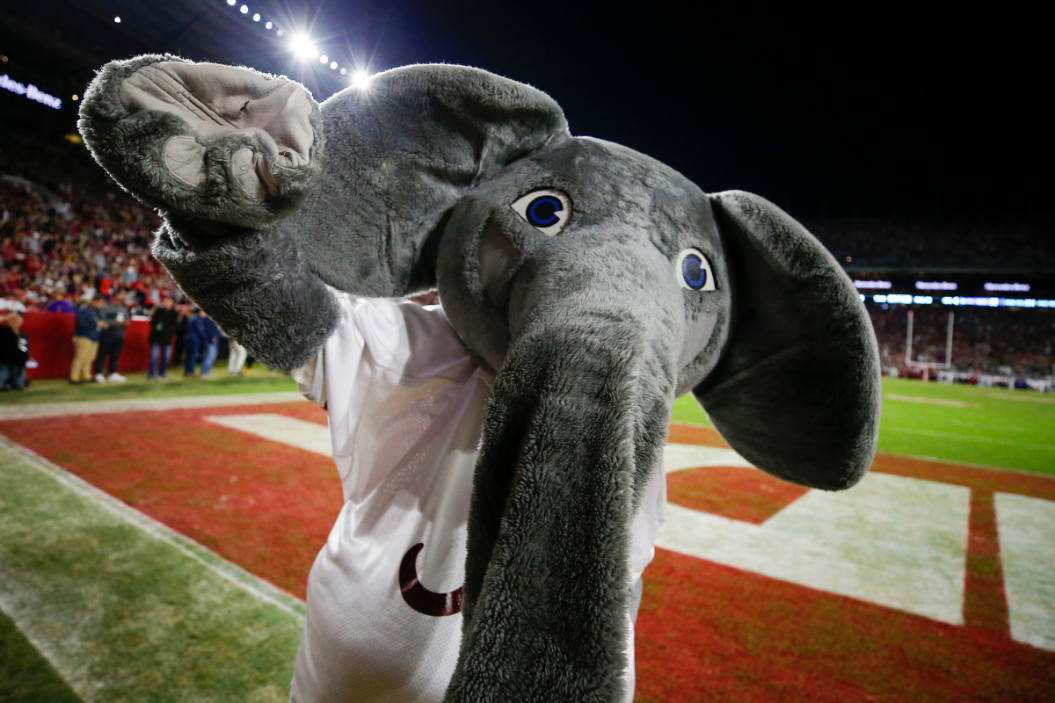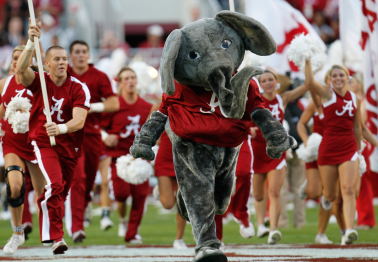The University of Alabama is home to many of the bests. Take a trip to Tuscaloosa and you'll find Nick Saban, who is undoubtedly the greatest college football coach of our generation. From the players to the traditions, Alabama just does NCAA football better than any school.
Even the Alabama Crimson Tide's elephant mascot, Big Al, is considered the GOAT when it comes to the big, furry friends that roam college football's sidelines. The gray, anthropomorphic elephant has been the team's official mascot since 1979, when Bear Bryant finally approved the trunked animal despite a history that dates back to 1930. A sportswriter named Everett Strupper wrote about how head coach Wallace Wade's Alabama team's big and aggressive linemen resembled elephants after pounding Mississippi, 64-0. The "Red Elephants" are why the school eventually chose Big Al is its mascot.
More than 40 years since Big Al earned the stamp of approval, he's still spreading spirit at Bryant-Denny Stadium and other Alabama athletics events. It's not uncommon to find him high-fiving Tide fans on The Quad before Alabama football games, dancing on the sidelines or even crowd surfing up the UA student section in the fourth quarter against opponents like Auburn, Ole Miss, Florida, LSU, Tennessee and Arkansas.
Being Big Al isn't as easy as it looks, however. He's played by five different students — two guys and three girls. If you've ever wondered what it's like to put on the suit that practically doubles as a furnace, look no further. We talked to two Big Als — one who currently plays him and one who used to — to understand exactly what life as 'Bama's mascot is like.
Trey Dickey is a senior from Birmingham, Alabama, studying creative media and communications studies. He became Big Al in the spring of 2019 and is currently one of five students on the Big Al team.
William Webster spent four years as Big Al from 2018 to 2021. The John's Creek, Georgia, native studied finance and communications studies before graduating earlier this year.

Courtesy of Trey Dickey
Q: Why did you want to become Big Al?
Dickey: "That's actually a really funny story. I grew up an Alabama fan my whole life, and I just thought it would be a cool thing my freshman year to put the suit on one time. I had a roommate at the time that was trying to convince me to go to it. We both went to the tryout together. After a few rounds, he got dropped. That's when I realized this isn't just for fun. This isn't just something that people come to the tryout to be Big Al for two days. It's something that people do for like a scholarship. It's pretty much a part-time job. That's when it really hit me. I think that really helped me in the tryout, being more relaxed and not caring as much about the outcome and caring more about just having a good time, because that's what Big Al would wanna do. That's what helped me the most in my tryout."
Q: I'm guessing you fell in love with it.
Dickey: "Oh yeah, Big Al is one of my best friends. All of the Big Als that played Big Al are a very close community to me. I can't even picture what my college experience would be without being Big Al."
Q: How does being Big Al work with multiple people?
Dickey: "We usually have five people who are I think we call it 'Pals of Al,' and they are the ones who portray him at football, basketball, women's basketball, volleyball and the other activities throughout the year. He actually does 500 activities outside of the sporting events that he attends, so he's a very busy guy. We have to divvy that up between us."
Q: Something tells me Big Al is pretty busy on Saturdays.
Dickey: "Oh yeah, oh yeah."
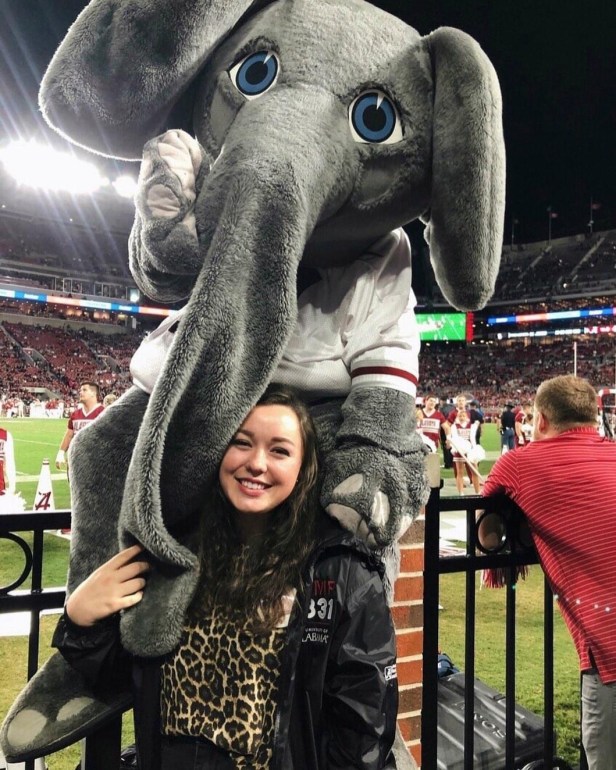
Courtesy of Trey Dickey
Q: What was the process of becoming Big Al? How did the audition go?
Dickey: "The tryout for Big Al — he's a very creative guy. The biggest thing to look for in someone who wants to be a Big Al is are they creative enough to think on the spot and are they animated enough? So Big Al's suit is different from a lot of other mascots. He's a very large person, and so usually we have people on the team that are very athletic build. We don't have people that are very large, so making sure we have people who can be very animated with their full body movements is super important. We put people in suit for different rounds. We have a round that is just the walk. Big Al has a significant walk that is a trademark of who he is. He has a signature, so we practice the signature and teach it to other people. We also have prop usage. What that is is we'll have a room with three random props in it. You won't know what the props are beforehand. Big Al walks in to the room and he has to interact with the props in multiple different ways, but he can't use any of the props for their intended purpose. So that's kind of looking for the creativity part. Then we as the judges have to guess what he's trying to do with the props. It really shows you if people can think on the spot, because Big Al is very creative and very playful, so he's always looking for something to play with...There are some people who just will freeze and have to think for a second. Big Al never stops moving, and so that is a huge aspect of who he is."
Q: Take me through a game day as Big Al in Tuscaloosa.
Dickey: "We usually arrive at our cart — we call it the rammer jammer or the RJ — we'll arrive five hours before the football game. We'll get all of our equipment over, all of our props for the day over to the stadium. We have five different assignments for every game day split between all five of us. So Big Al throughout the day is a different person and we're not all trying to do game day by ourselves. It takes all five of us. The first shift is Quad. So Quad is everything that happens before Big Al even arrives in the stadium. We'll take Big Al around the Quad, we'll drive him around and he'll wave to kids and everybody tailgating. We also have 'Elephant Stomp' which is at Gorgas Library. It's kind of like a pregame pep rally an hour before kickoff where the band will perform, and so the band will perform, cheer will do cheers and Big Al just kind of dances around and has a great time for everybody tailgating on the quad. From there, we drive back to the stadium and the next person gets in the suit. The next person's assignment is pregame and halftime. Pregame, you're in charge of marching the band out on to the field. After you march them on to the field they will play 'Tusk,' which is sort of Big Al's statement song. The band will form an elephant on the field and Big Al will march them down the field. They play 'Tusk' and it's just kind of a cool little tradition we have.
"Once that's over, he runs the team out. That person will go back into the locker room and the next Big Al will come out for the first quarter. That person is in charge of the first quarter and third quarter, because in the third quarter we do box visits. So very rarely will you see Big Al on the sideline in Bryant-Denny during the third quarter because he's actually up in the boxes visiting people up there. And then second quarter is kind of their own thing and that will bleed into halftime depending on how long it takes to set up props for the person doing the halftime skit. So at halftime we usually prepare a little short skit where like a costume that Big Al will wear. It's just kind a fun way to be creative on game day. The third quarter we do box visits. After box visits, Big Al will come back in a white jersey. Big Al wears a white jersey for the fourth quarter of football games. It's just a small little tradition that not a lot of people know about probably. It's just kind of a little thing we do. He'll come out and do the fourth quarter things, the traditions. If there are enough students in the student section and we're ahead by enough points, Big Al will body surf up the student section, and that's always a fun experience. If there's not enough students like if it's super hot one day and there's not a lot of students left and it's a blowout game, he won't body surf because that's just kind of tacky. It doesn't look very good. If it's a close game he won't body surf, because we don't wanna count our chickens."
Q: What's the story behind the white jersey tradition?
Dickey: "I'm not actually sure why, but it's just always been the thing that Big Al does. The fourth quarter is kind of important to Alabama fans in general. It kind of symbols a sign of 'we made it, let's finish this.' So Big Al wearing his white jersey is a part of that tradition. Everyone puts their fours in the air. They play the Green Day song ["Basket Case"]. The cheerleaders will tumble through the end zone. Most of our traditions happen in the fourth quarter. It's just a great opportunity for Big Al to stand out because all of our players are going to be wearing red every home game. Wearing white in the fourth quarter really makes him pop out."

William Webster poses with a fellow Big Al during the College Football Playoff National Championship Game at Levi's Stadium in Santa Clara, California, on January 7, 2019. Photo courtesy of William Webster.
Q: What's crowd surfing up the student section like?
Webster: "It's fun. It's relaxing. Crowd surfing is kind of a five minute lay-down-catch-your-breath situation. Since you see out of the corner of your eyes the way they push you up you can see yourself on the screen whenever they put you on the screen. Thankfully I never had any problems with it. I never felt like I was going to be dropped. I'm not bulky by any means so it was never hard for people to lift me up. I've always had good experiences with it. They always get us to the top."
Q: I guess Big Al can't be too heavy then...
Webster: "Yeah, there was one year that this guy tried out who was 6-foot-7. He wasn't fat. He was just thick and tall. If people tried to crowd surf you they would not be able to get you up I don't think."
Q: So you have to have a certain height and weight to be Big Al?
Webster: "We probably have people that range from 5-foot-9 to 6-foot-2 is the tallest we've had. So within that sort of height. Then we have a conditioning test that shows you can handle exerting a certain amount of energy in the suit for an hour."
Q: Are people allowed to know that you're Big Al?
Dickey: "We try to keep it a secret for the most part, because we don't want to be on the Quad as Big Al and there be a bunch of kids around us and some drunk college student come and be like, 'Is that trey in there?' Because those kids will be like, 'What? That's just Big Al.' It's kind of about the kids. We do have a roster on rolltide.com. We're in the program for the football team. Our pictures are out there so it's not a huge secret but it is something that we kind of keep a secret because it's special."
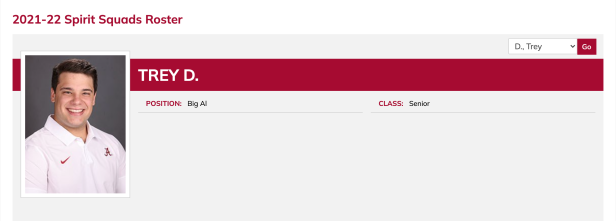
Screenshot from RollTide.com.
Q: OK, what's it like wearing that suit? How hot is it? Do you trip a lot?
Dickey: "Big Al has a very unconventional suit. He's a very unconventional mascot in general. The fact that he's an elephant, it's just not something you see very often. You see a lot of tigers, a lot of dogs. Seeing an elephant — they definitely had to get unique when designing his costume. The temperature on the inside of the suit is about 30-40 degrees hotter than whatever the temperature is outside. So if it's a pretty day and it's only about 70 degrees, it's probably around 100-110 degrees inside the suit. That does get problematic for our September games that are upwards of 98 degrees. The biggest part that we do as a team is we work out. We work out every Tuesday and Thursday at 5:30 in the morning. So we have to pass a conditioning test to prove we have the athletic stamina to be Big Al. The biggest thing is that we're viewed as student-athletes. So that's a cool thing that we get the respect from the university. We're not just some kid that's dressing up. We're actually athletes at the university just as much as a cheerleader is. Our head is actually larger than most university mascots. It probably weighs about 30 pounds and that's all sitting on your head and your neck. That's a lot of weight on your neck. Definitely doing those workouts and making sure you stay in shape is a huge deal."
Webster: "It's definitely crazy hot. If you picture your vision on a clock from 9-3 you can't see from 11-1 o'clock. That's kind of where the trunk and the nose is. Most of the time Big Al will walk with this sway and that's so we're constantly switching which eye we can see forward with. You can never see straight in front of you, so when we're taking pictures you always have to put the camera in that blind spot. We always say if you can see the camera, Big Al is looking somewhere else. Then all your gestures get swallowed since it's such a big suit. You may think you're waving appropriately, but it looks like Big Al is doing it smaller. Your movements have to be so much larger and exaggerated in order to make it look like Big Al is excited acting out those gestures. The no thumbs — that takes some getting used to. Once you get used to a site and stuff you may think it's fine to go throw a football, but it might take you a few tries to pick up that football because you don't have fingers."
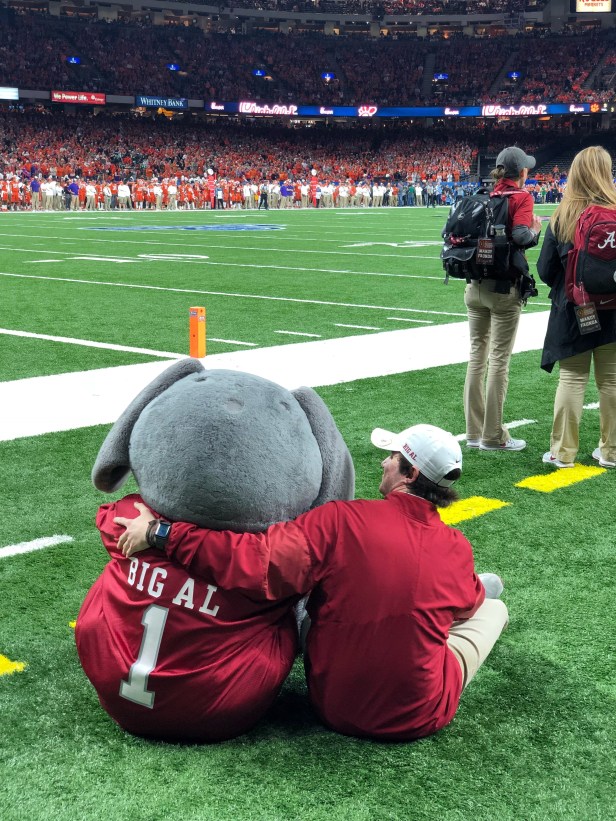
Courtesy of William Webster
Q: Wait, can Big Al pick things up? Can he throw a football?
Webster: "You can. It just takes some practice, for sure. We have to learn his signature, too. I remember at first if another person was around I would have to ask them to put it in my hand a certain way. Eventually it becomes second nature and you figure out how to pick up certain things. You get better at it after a few months being in suit. Thankfully part of Big Al's character is being clumsy."
Q: Does Alabama pay you to be Big Al?
Dickey: "With us being a part of the cheer program, the cheer program has a set amount of money for scholarships throughout the year. That gets divvied up through cheerleaders and Big Al. Usually, if you're a first-year on the team you get a little bit less than everyone else on the team. The more you return and the more you dedicate to the program, the more you get in scholarship money. None of us even have close to a full scholarship. It's definitely not the reason to be Big Al. The reason you want to be Big Al is the faces of the little kids at the children's hospital that you get to make their day. It's the interactions you get to have with people in other circumstances you would never get to meet. You get to make everyone's day. Big Al walks into the room and everyone lights up. That's really the payment. We do get a little bit of scholarship money just because we do so much for the university. They feel like they'd like to invest back into us, which really means a lot that the university would give money to the cheer program."
Q: How much does the school pay you?
Webster: "I think it's on the website too but if a corporate company wants Big Al its $400 to the university. But if you wanted Big Al for a private event that would be like $100. That would go to us. The birthday parties we can keep. The bigger ones go to the school."
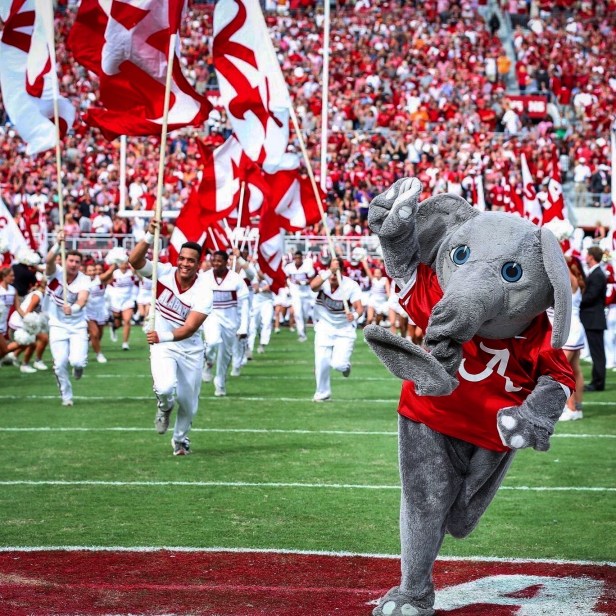
Courtesy of William Webster
Q: What was your favorite game or moment as Big Al?
Dickey: "My favorite game...we lost the game. LSU in 2019 was probably my favorite environment in sports. The president came to the football game. We had College Gameday in the morning. We had SEC Nation. We had Good Morning America. All these things and the game was at 2:30. We were up for all of those morning shows. We met at 5:30 a.m. and we didn't get home until like 10:30. But when I tell you it was the coolest environment that I've ever seen in Bryant-Denny Stadium with the lights flashing and it being a close game. The students were really involved in the game. That was probably one of the coolest experiences I had as Big Al. The best experience I ever had as Big Al was when I was at a children's hospital. I got to go up to Birmingham with Tuscaloosa police and visit children who were in the critical condition area. It was heartwarming because I myself was crying in suit as I was talking to these children — or, interacting. They were telling me about how much I made their day. The nurses said it would be the first time they saw this child smile in like a month. I was crying in suit but I had to act like as if Big Al were happy. That was definitely the most challenging event, but it was definitely the most rewarding because I think I got the most out of that one."
Q: Were you ever attacked as Big Al?
Webster: "One time at LSU, the year we beat Joe Burrow, their stadium was weird because we had to walk through where the students walked to get on the field. The other guy who was there was Big Al, and this one dude came up and started pushing on Big Al. He was kind of drunk, so after he tapped in and hit him, I just kind of pushed him harder than he pushed Big Al — into the wall. He looked at me like we were gonna start something, but then I grabbed Big Al and said, 'Let's go!' and kind of ran onto the field and all was good...thankfully nothing too bad."
Q: Of course it was LSU...
Webster: "Exactly."
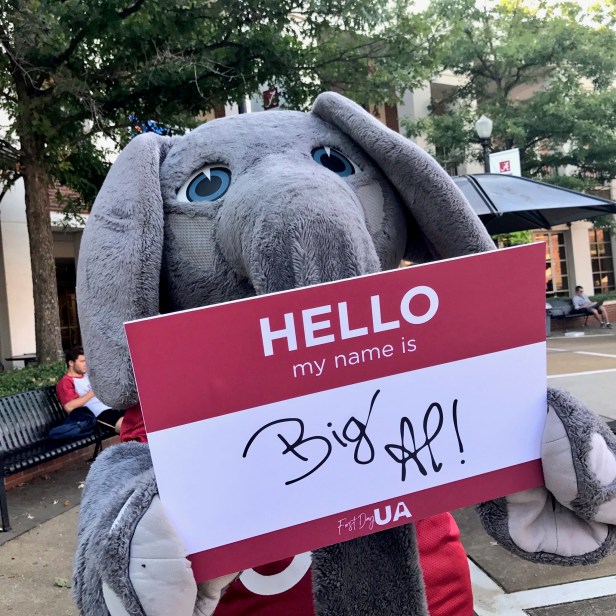
Courtesy of Trey Dickey
Q: Do you feel like there's more pressure to be Alabama's mascot over other schools?
Dickey: "There definitely is. It's a little bit of both. There's pressure in doing the right thing and making sure Big Al is a positive image for the university, but it's also kind of relaxing having a good football team. A majority of the fan base is actually caring about the game, so you can focus on the little kids and the people who really want to see Big Al. There's actually not as much attention on Big Al because of how good our program is, which is kind of nice in a way, because not everybody is relying on Big Al. But there is a little bit of pressure about image. We have different people we have to go through to post things on social media. Of course, Big Al has very rigorous training to make sure that we're not going to do anything questionable."
Q: Who's the best mascot in college football?
Webster: "Oh, Big Al. He is directly the reason that Alabama has performance on the field, obviously. I don't think our team performs as well if Big Al doesn't get the fans into it. Every player is instantly thinking, 'Oh, I'm not here to make it to the NFL. I'm here to make Big Al proud.' It just runs deep. It's an innate thing that everyone deep down knows but won't admit it...I'm kidding. Big Al is just the best. It's kind of like is a parent every gonna say someone else in his kid's class is the best kid? It's almost like that...Big Al is just the best. He's cute. He's fun. I don't know how else to put it."
